Enhanced Electricity Generation and Heavy Metal Removal by a Rutile–Biochar Cathode MFC
Abstract
:1. Introduction
2. Materials and Methods
2.1. Chemical Reagents for the Experiment
2.2. Preparation of Biochar and Rut-B
2.3. Characterization of Composite Materials
2.4. Construction of MFC
2.5. Determination of Pollutant Degradation Performance
3. Results and Discussion
3.1. Characterization of Biochar, Rutile, and Rut-B
3.2. System Efficiency and Potential Characteristics of MFCs
3.3. Study on the Degradation of Heavy Metal Pollutants by MFCs
3.4. Study on the Cyclic Degradation Performance of MFCs
3.5. Mechanism of Rut-B Cathode Catalysis
4. Conclusions
Author Contributions
Funding
Data Availability Statement
Conflicts of Interest
References
- Gao, Q.; Tao, D.W.; Qi, Z.B.; Liu, Y.F.; Guo, J.; Yu, Y. Amidoxime functionalized PVDF-based chelating membranes enable synchronous elimination of heavy metals and organic contaminants from wastewater. J. Environ. Manage. 2022, 318, 115643. [Google Scholar] [CrossRef] [PubMed]
- Maiti, S.; Ghosh, N.; Mandal, C.; Das, K.; Dey, N.; Adak, M.K. Responses of the maize plant to chromium stress with reference to antioxidation activity. Braz. J. Plant Physiol. 2012, 24, 203–212. [Google Scholar] [CrossRef]
- Shaikh, A.; Mishra, S.P.; Mohapatra, P.; Parida, S. One-step solvothermal synthesis of TiO2-reduced graphene oxide nanocomposites with enhanced visible light photoreduction of Cr(VI). J. Nanopart. Res. 2017, 19, 206. [Google Scholar] [CrossRef]
- Briffa, J.; Sinagra, E.; Blundell, R. Heavy metal pollution in the environment and their toxicological effects on humans. Heliyon 2020, 6, e04691. [Google Scholar] [CrossRef]
- Dytlow, S.; Gorka-Kostrubiec, B. Concentration of heavy metals in street dust: An implication of using different geochemical background data in estimating the level of heavy metal pollution. Environ. Geochem. Health 2021, 43, 521–535. [Google Scholar] [CrossRef]
- Yang, Q.; Li, Z.; Lu, X.; Duan, Q.; Huang, L.; Bi, J. A review of soil heavy metal pollution from industrial and agricultural regions in China: Pollution and risk assessment. Sci. Total Environ. 2018, 642, 690–700. [Google Scholar] [CrossRef]
- Pandiyan, J.; Mahboob, S.; Govindarajan, M.; Al-Ghanim, K.A.; Ahmed, Z.; Al-Mulhm, N.; Jagadheesan, R.; Krishnappa, K. An assessment of level of heavy metals pollution in the water, sediment and aquatic organisms: A perspective of tackling environmental threats for food security. Saudi J. Biol. Sci. 2021, 28, 1218–1225. [Google Scholar] [CrossRef]
- Jeong, H.; Lee, Y.; Moon, H.; Ra, K. Characteristics of metal pollution and multi-isotopic signatures for C, cu, zn, and pb in coastal sediments from special management areas in korea. Mar. Pollut. Bull. 2023, 188, 114642. [Google Scholar] [CrossRef]
- Rajendran, S.; Priya, T.A.K.; Khoo, K.S.; Hoang, T.K.A.; Ng, H.S.; Munawaroh, H.S.H.; Karaman, C.; Orooji, Y.; Show, P.K. A critical review on various remediation approaches for heavy metal contaminants removal from contaminated soils. Chemosphere. 2021, 287, 132369. [Google Scholar] [CrossRef]
- Yaqoob, A.A.; Ibrahim, M.N.M.; Guerrero-Barajas, C. Modern trend of anodes in microbial fuel cells (MFCs): An overview. Environ. Technol. Innov. 2021, 23, 101579. [Google Scholar] [CrossRef]
- Daud, N.N.M.; Ahmad, A.; Yaqoob, A.A.; Ibrahim, M.N.M. Application of rotten rice as a substrate for bacterial species to generate energy and the removal of toxic metals from wastewater through microbial fuel cells. Environ. Sci. Pollut. Res. 2021, 28, 62816–62827. [Google Scholar] [CrossRef]
- Patel, A.; Choi, Y.; Sim, S. Emerging prospects of mixotrophic microalgae: Way forward to sustainable bioprocess for environmental remediation and cost-effective biofuels. Bioresour. Technol. 2020, 300, 122741. [Google Scholar] [CrossRef]
- AlSayed, A.; Soliman, M.; Eldyasti, A. Microbial fuel cells for municipal wastewater treatment: From technology fundamentals to full-scale development. Renew. Sustain. Energy Rev. 2020, 134, 110367. [Google Scholar] [CrossRef]
- Idris, S.A.; Esat, F.N.; Abd Rahim, A.A.; Rizzqi, W.A.Z.; Ruzlee, W.; Razali, W.M.Z. Electricity generation from the mud by using microbial fuel cell. Matec Web Conf. 2016, 69, 02001. [Google Scholar] [CrossRef]
- Lovley, D. Bug juice: Harvesting electricity with microorganisms. Nat. Rev. Microbiol. 2006, 4, 487–508. [Google Scholar] [CrossRef] [PubMed]
- Li, W.; Yu, H.; Zhen, H. Towards sustainable wastewater treatment by using microbial fuel cells-centered technologies. Energ. Environ. Sci. 2014, 7, 911–924. [Google Scholar] [CrossRef]
- Mian Chen, B.Y.; Tobias, M.B.; Rakan, M.A.; Peter, G.P. Composition Dependence of Ethanol Oxidation at Ruthenium. J. Electrochem. Soc. 2018, 165, J3019–J3025. [Google Scholar] [CrossRef]
- Aelterman, P.; Rabaey, K.; Pham, H.T.; Boon, N.; Verstraete, W. Continuous electricity generation at high voltages and currents using stacked microbial fuel cells. Environ. Sci. Technol. 2006, 40, 3388–3394. [Google Scholar] [CrossRef]
- Shi, L.; Dong, H.L.; Reguera, G.; Beyenal, H.; Lu, A.H.; Liu, J.; Yu, H.Q.; Fredrickson, J.K. Extracellular electron transfer mechanisms between microorganisms and minerals. Nat. Rev. Microbiol. 2016, 14, 651–662. [Google Scholar] [CrossRef]
- Katuri, K.P.; Kalathil, S.; Ragab, A.; Bian, B.; Alqahtani, M.F.; Pant, D.; Saikaly, P.E. Dual-function electrocatalytic and macro-porous hollow-fiber cathode for converting waste streams to valuable resources using microbial electrochemical systems. Adv. Mater. 2018, 30, e1707072. [Google Scholar] [CrossRef]
- Pandit, S.; Savla, N.; Jung, S. Recent advancements in scaling up microbial fuel cells. In Integrated Microbial Fuel Cells for Wastewater Treatment; Butterworth-Heinemann: Oxford, UK, 2020; pp. 349–368. [Google Scholar]
- Badi, N.; Theodore, A.M.; Alghamdi, S.A.; Al-Aoh, H.A.; Lakhouit, A.; Roy, A.S.; Ignatiev, A. Fabrication and Characterization of Flexible Solid Polymers Electrolytes for Supercapacitor Application. Polymers 2022, 14, 3837. [Google Scholar] [CrossRef] [PubMed]
- Jung, S.; Mench, M.M.; Regan, J.M.; Oak Ridge National Lab (ORNL); Oak Ridge, TN (United States). Impedance characteristics and polarization behavior of a microbial fuel cell in response to short-term changes in medium pH. Environ. Sci. Technol. 2011, 45, 9069–9074. [Google Scholar] [CrossRef] [PubMed]
- Jung, S. Impedance analysis of geobacter sulfurreducens PCA, shewanella oneidensis MR-1, and their coculture in bioeletrochemical systems. International Int. J. Electrochem. Sci. 2012, 7, 11091–11100. [Google Scholar] [CrossRef]
- Kang, H.; Jeong, J.; Gupta, P.L.; Jung, S.P. Effects of brush-anode configurations on performance and electrochemistry of microbial fuel cells. Int. J. Hydrog. Energy 2017, 42, 27693–27700. [Google Scholar] [CrossRef]
- Ogan, B.E.; Hamelers, B.; Rozendal, R.; Schröder, U.; Keller, J.; Freguia, S.; Aelterman, P.; Verstraete, W.; Rabaey, K. Microbial fuel cells: Methodology and technology. Environ. Sci. Technol. 2006, 40, 5181–5192. [Google Scholar]
- Zhou, M.; Chi, M.; Luo, J. An overview of electrode materials in microbial fuel cells. J. Power Sources 2011, 196, 4427–4435. [Google Scholar] [CrossRef]
- Rahman, S.; Balushi, N.J.; Nayak, J.K.; Al-Mamun, A.; Al-Abri, M.; Alawi, M.; Sana, A. A review on semiconductor photocathode in bio electrochemical systems: Mechanism, limitation, and environmental application. Mater. Today Sustain. 2023, 22, 100349. [Google Scholar] [CrossRef]
- Koo, B.; Jung, S.P. Improvement of air cathode performance in microbial fuel cells by using catalysts made by binding metal-organic framework and activated carbon through ultrasonication and solution precipitation. Chem. Eng. J. 2017, 424, 130388. [Google Scholar] [CrossRef]
- Koo, B.; Lee, S.; Oh, S.; Kim, E.J.; Hwang, Y.; Seo, D.; Kim, J.Y.; Kahng, Y.H.; Lee, Y.W.; Chung, S.; et al. Addition of reduced graphene oxide to an activated-carbon cathode increases electrical power generation of a microbial fuel cell by enhancing cathodic performance. Electrochim. Acta 2019, 297, 613–622. [Google Scholar] [CrossRef]
- Touach, N.; Benzaouak, A.; Toyir, J.; El Hamidi, A.; El Mahi, M.; Lotfi, E.M.; Kacimi, M.; Liotta, L.F. Bioenergy Generation and Wastewater Purification with Li0.95Ta0.76Nb0.19Mg0.15O3 as New Air-Photocathode for MFCs. Catalysts 2022, 12, 1424. [Google Scholar] [CrossRef]
- Zhao, X.; Ke, Z.; Wang, Q. Efficient organic contaminant and Cr(VI) synchronous removing by one-step modified molybdenite cathode microbial fuel cells. Env. Sci. Pollut. R 2023, 30, 4423–4434. [Google Scholar] [CrossRef] [PubMed]
- Xu, H.T.; Wang, L.G.; Wen, Q.; Chen, Y.; Qi, L.J.; Huang, J.X.; Tang, Z.S. A 3D porous NCNT sponge anode modified with chitosan and polyaniline for high-performance microbial fuel cell. Bioelectrochemistry 2019, 129, 144–153. [Google Scholar] [CrossRef] [PubMed]
- Lu, G.L.; Zhu, Y.L.; Lu, L.; Xu, K.L.; Wang, H.M.; Jin, Y.H.; Ren, Z.J.; Liu, Z.N.; Zhang, W. Iron-rich nanoparticle encapsulated, nitrogen doped porous carbon materials as efficient cathode electrocatalyst for microbial fuel cells. J. Power Sources 2016, 315, 302–307. [Google Scholar] [CrossRef]
- Ren, G.P.; Ding, H.R.; Li, Y.; Lu, A.H. Natural hematite as a low-cost and earth-abundant cathode material for performance improvement of microbial fuel cells. Catalysts 2016, 6, 157. [Google Scholar] [CrossRef]
- Lu, A.H.; Li, Y.; Jin, S.; Wang, X.; Wu, X.L.; Zeng, C.P.; Li, Y.; Ding, H.R.; Hao, R.X.; Lv, M.; et al. Growth of non-phototrophic microorganisms using solar energy through mineral photocatalysis. Nat. Commun. 2012, 3, 768. [Google Scholar] [CrossRef]
- Zlámalová, M.; Lásková, P.; Vinarčíková, M.; Zukalová, M. Inherent electrochemical activity of TiO2 (anatase, rutile) enhances the charge capacity of cathodes of lithium-sulfur batteries. J. Solid State Electrochem. 2022, 26, 639–647. [Google Scholar] [CrossRef]
- Li, C.; Song, Y.; Wang, X.; Zhang, Q. Synthesis, characterization and application of S-TiO2/PVDF-g-PSSA composite membrane for improved performance in MFCs. Fuel 2020, 264, 116847. [Google Scholar] [CrossRef]
- Ren, G.P.; Sun, Y.; Lu, A.H.; Li, Y.; Ding, H.R. Boosting electricity generation and Cr(VI) reduction based on a novel silicon solar cell coupled double-anode (photoanode/bioanode) microbial fuel cell. J. Power Sources 2018, 408, 46–50. [Google Scholar] [CrossRef]
- Chen, Q.; Liu, L.; Liu, L.; Zhang, Y. A novel UV-assisted PEC-MFC system with CeO2/TiO2/ACF catalytic cathode for gas phase VOCs treatment. Chemosphere 2020, 255, 126930. [Google Scholar] [CrossRef]
- Cai, T.; Huang, M.H.; Huang, Y.X.; Zheng, W. Enhanced performance of microbial fuel cells by electrospinning carbon nanofibers hybrid carbon nanotubes composite anode. Int. J. Hydrog. Energy. 2019, 44, 3088–3098. [Google Scholar] [CrossRef]
- Chang, H.; Gustave, W.; Yuan, Z. One-step fabrication of binder-free air cathode for microbial fuel cells by using balsa wood biochar. Environ. Technol. Innov. 2020, 18, 100615. [Google Scholar] [CrossRef]
- Ramya, M.; Harsha, V.K.; Senthil, K.P. Metal mixed biochar electrodes for the generation of electricity with high power density in microbial fuel cell. Sustain. Energy Technol. Assess. 2022, 53 Pt B, 102549. [Google Scholar] [CrossRef]
- Yuan, Y.; Yuan, T.; Wang, D.; Tang, J.H.; Zhou, S.G. Sewage sludge biochar as an efficient catalyst for oxygen reduction reaction in a microbial fuel cell. Bioresour. Technol. 2013, 144, 115–120. [Google Scholar] [CrossRef] [PubMed]
- Wang, W.Y.; Zhao, Q.L.; Ding, J.; Wang, K.; Jiang, J.Q. Development of an MFC-powered BEF system with novel Fe–Mn–Mg/CF composite cathode to degrade refractory pollutants. J. Clean. Prod. 2021, 326, 129348. [Google Scholar] [CrossRef]
- Qu, K.J.; Huang, L.; Hu, S.Y.; Liu, C.; Yang, Q.Y.; Liu, L.H.; Li, K.; Zha, Z.P.; Wang, Z.X. TiO2 supported on rice straw biochar as an adsorptive and photocatalytic composite for the efficient removal of ciprofloxacin in aqueous matrices. J. Environ. Chem. Eng. 2023, 11, 109430. [Google Scholar] [CrossRef]
- Chen, J.; Zhang, W.; Li, X.; Huang, R.; Liu, Q.; Zhang, Y.; Gan, T.; Huang, Z.; Hu, H. Mutually supportive growth strategy to engineer a hollow biochar sphere-supported TiO2 composite with improved interfacial compatibility for efficient visible light-driven photocatalysis. J. Environ. Chem. Eng. 2023, 11, 110327. [Google Scholar] [CrossRef]
- Wang, R.; Wan, S.; Liu, B. Denitrification in perspective of carbon neutralization: CO2 emission reduction and electricity generation by Fe-anode and bio-cathode MFC. J. Water Process Eng. 2022, 48, 102868. [Google Scholar] [CrossRef]
- Singh, H.; Zhuang, S.Q.; Ingis, B.J.; Nunna, B.B.; Lee, E.S. Carbon-based catalysts for oxygen reduction reaction: A review on degradation mechanisms. Carbon 2019, 151, 160–174. [Google Scholar] [CrossRef]
- Li, C.; Liu, Y.; Luo, M.; Cao, J.; Fang, F.; Feng, Q.; Luo, J.; Hao, L.; Wang, C. Enhancing simultaneous electrosynthesis of CO2 and nitrogen removal in microbial fuel cell (MFC) cathode compartment by adding Fe–C/biochar compound substrates. J. Power Sources 2023, 560, 232707. [Google Scholar] [CrossRef]
- Chen, Z.; Zhu, B.K.; Jia, W.F.; Liang, J.H.; Sun, G.X. Can electrokinetic removal of metals from contaminated paddy soils be powered by microbial fuel cells? Environ. Technol. Innov. 2015, 3, 63–67. [Google Scholar]
- Song, T.S.; Zhang, J.; Hou, S.; Wang, H.; Zhang, D.; Li, S.; Xie, J. In situ electrokinetic remediation of toxic metal-contaminated soil driven by solid phase microbial fuel cells with a wheat straw addition. J. Chem. Technol. Biotechnol. 2018, 93, 2860–2867. [Google Scholar] [CrossRef]
- Bhowmick, G.D.; Das, S.; Ghangrekar, M.M.; Mitra, A.; Banerjee, R. Improved wastewater treatment by combined system of microbial fuel cell with activated carbon/TiO2 cathode catalyst and membrane bioreactor. J. Inst. Eng. Ser. A 2019, 100, 675–682. [Google Scholar] [CrossRef]
- Li, Y.; Liu, L.; Yang, F. Destruction of tetracycline hydrochloride antibiotics by FeOOH/TiO2 granular activated carbon as expanded cathode in low-cost MBR/MFC coupled system. J. Membr. Sci. 2017, 525, 202–209. [Google Scholar] [CrossRef]
- Liu, C.; Min, Y.; Zhang, A.; Si, Y.; Chen, J.; Yu, H.Q. Electrochemical treatment of phenol-containing wastewater by facet-tailored TiO2: Efficiency, characteristics and mechanisms. Water Res. 2019, 165, 114980. [Google Scholar] [CrossRef]
- Zhao, J.; Cheng, L.; Wang, J.; Liu, Y.Y.; Yang, J.; Xu, Q.Z.; Chen, R.S.; Ni, H.W. Heteroatom-doped carbon nanofilm embedded in highly ordered TiO2 nanotube arrays by thermal nitriding with enhanced electrochemical activity. J. Electroanal. Chem. 2019, 852, 113513. [Google Scholar] [CrossRef]
- Zhang, Z.K.; Zhu, Z.Y.; Shen, B.X.; Liu, L.N. Insights into biochar and hydrochar production and applications: A review. Energy. 2019, 171, 581–598. [Google Scholar] [CrossRef]
- Li, Y.; Li, H.; Huang, W. Research progress on the biochar production and its applications in enhancing electron transport and catalysis performance. Res. Environ. Sci. 2021, 34, 1157–1167. [Google Scholar]
- Liang, B.; Li, K.; Liu, Y.; Kang, X. Nitrogen and phosphorus dual-doped carbon derived from chitosan: An excellent cathode catalyst in microbial fuel cell. Chem. Eng. J. 2019, 358, 1002–1011. [Google Scholar] [CrossRef]
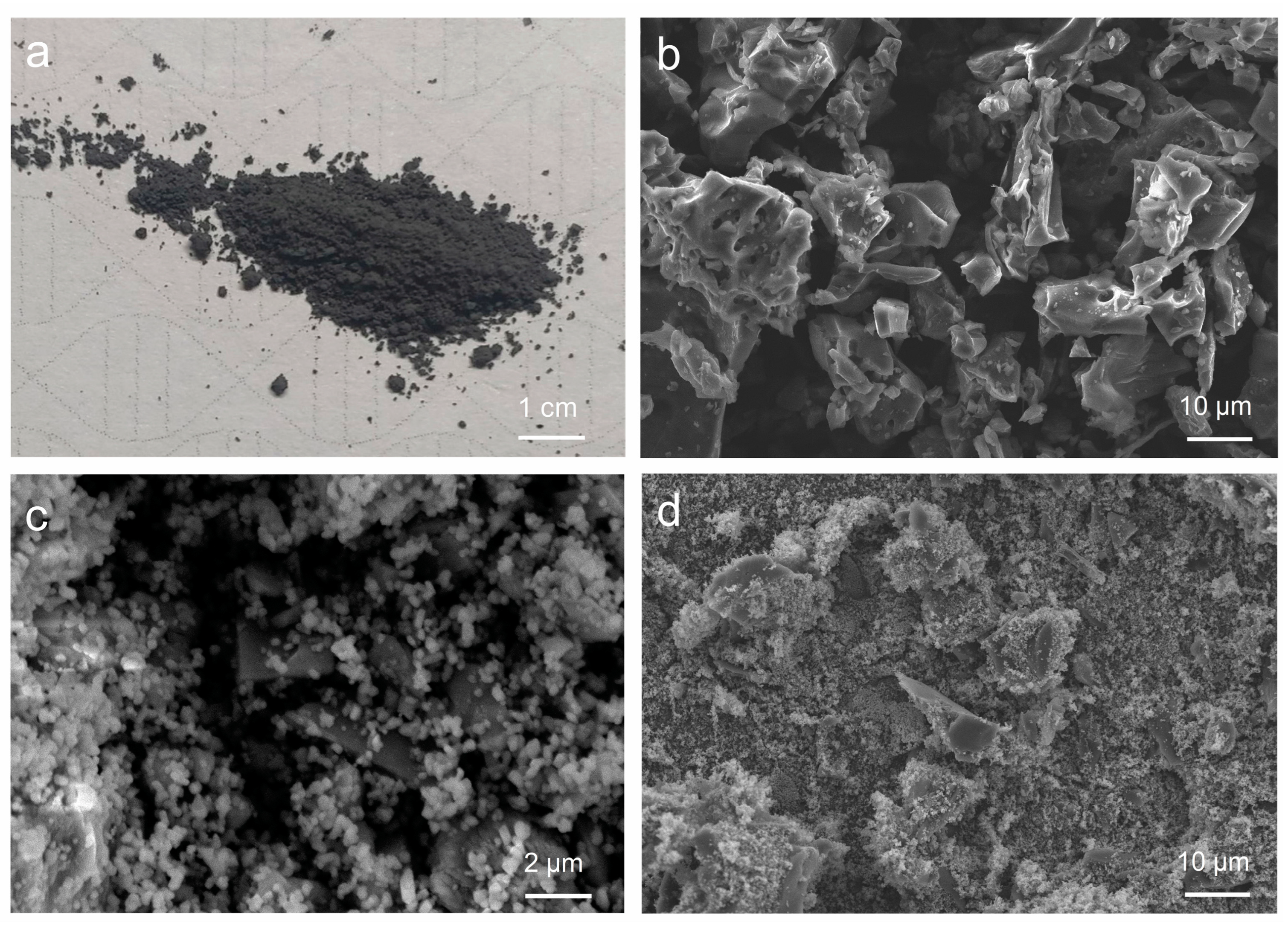
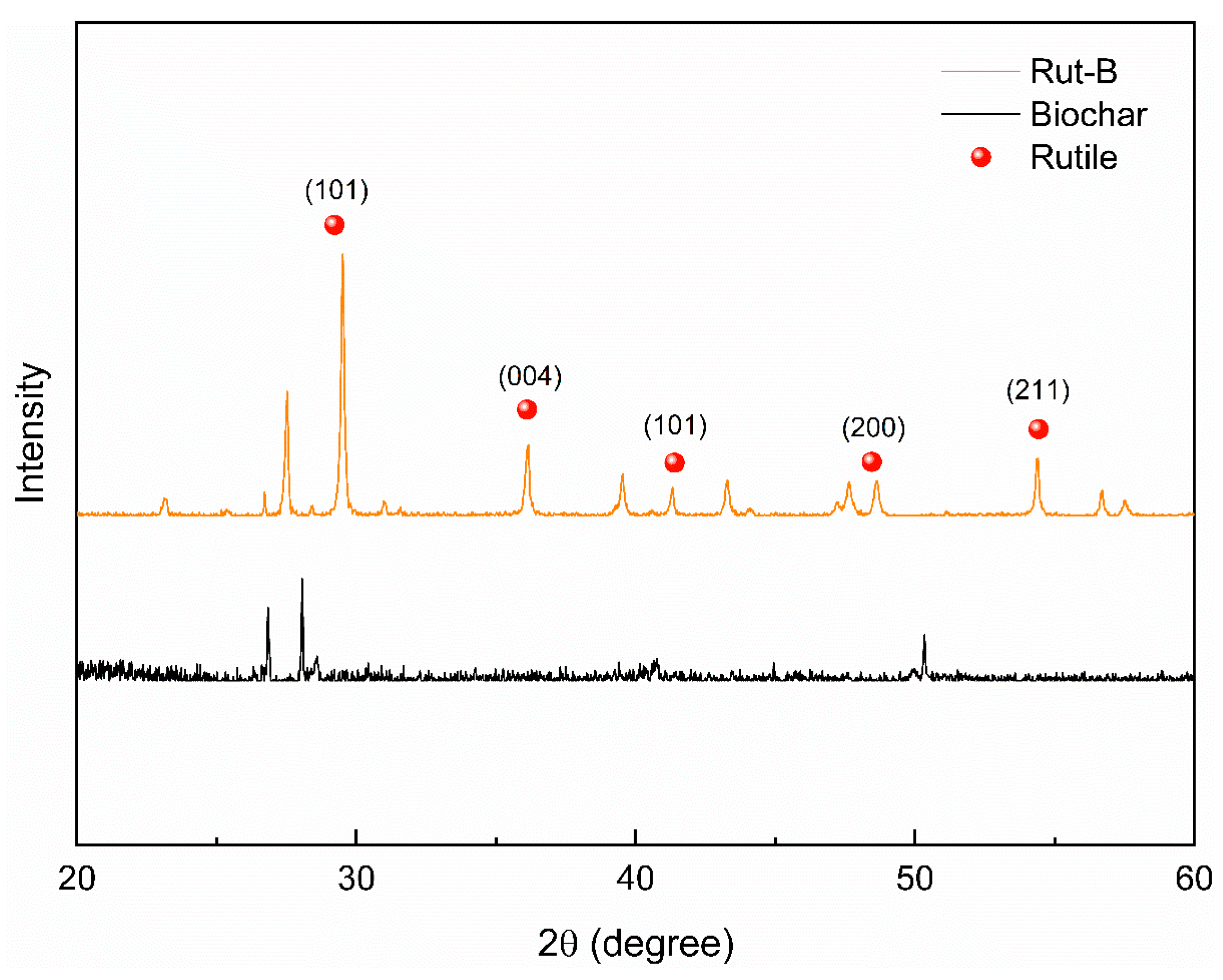
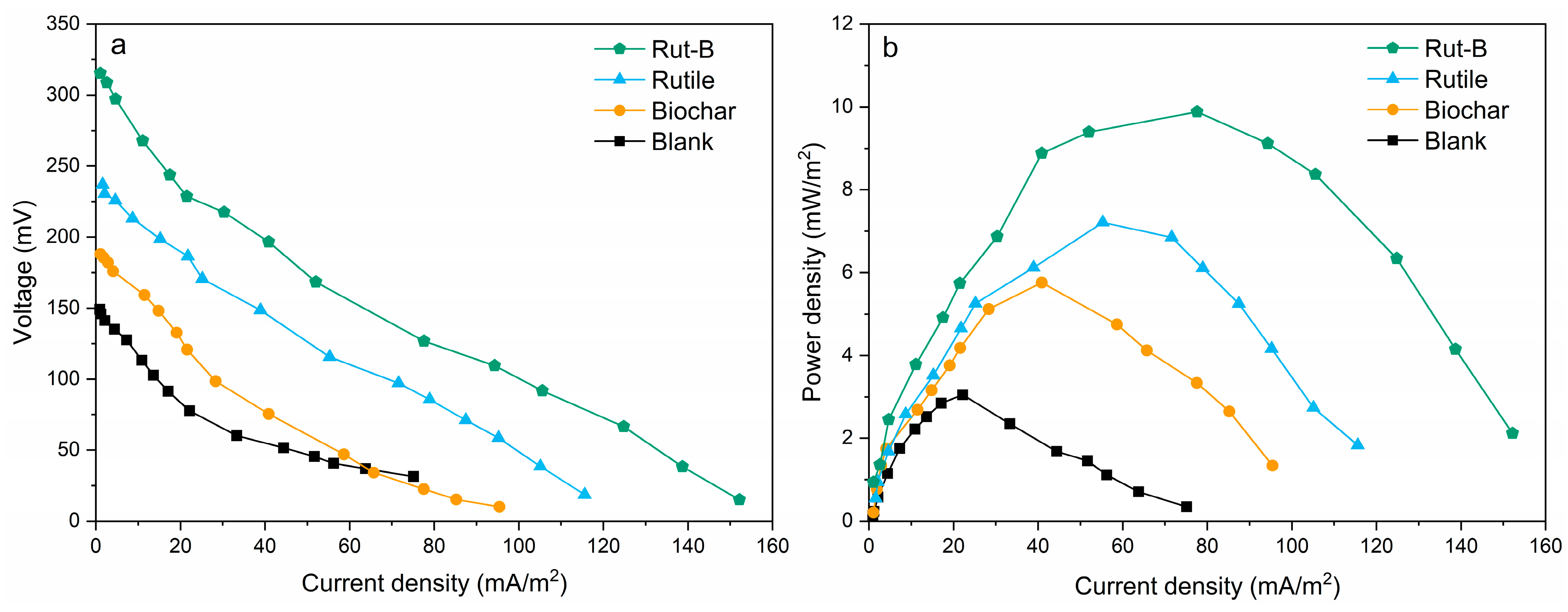
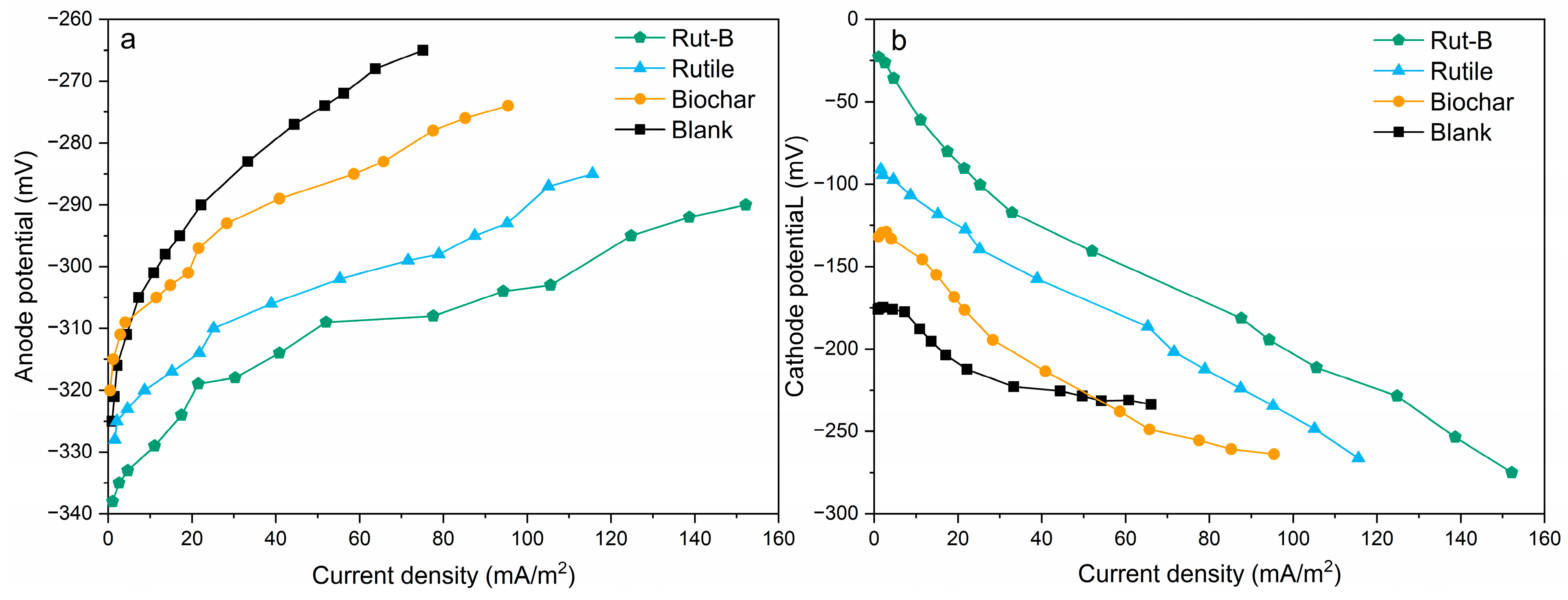

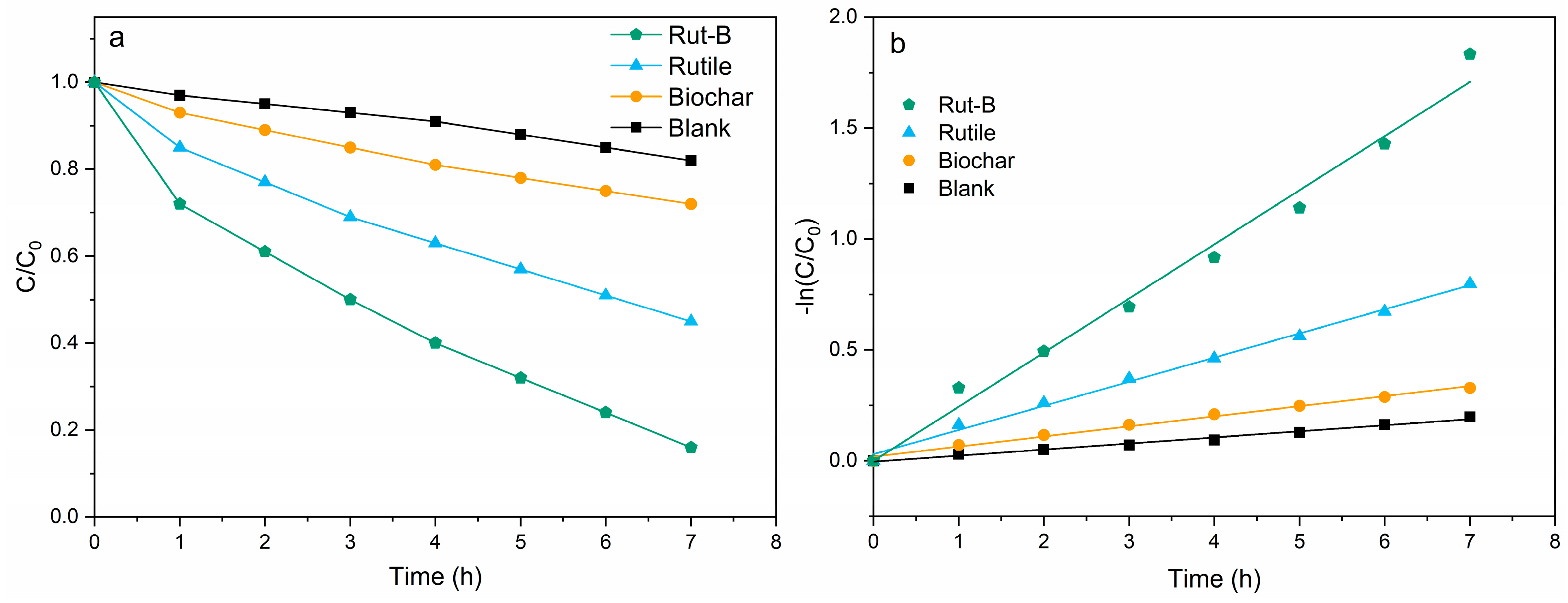
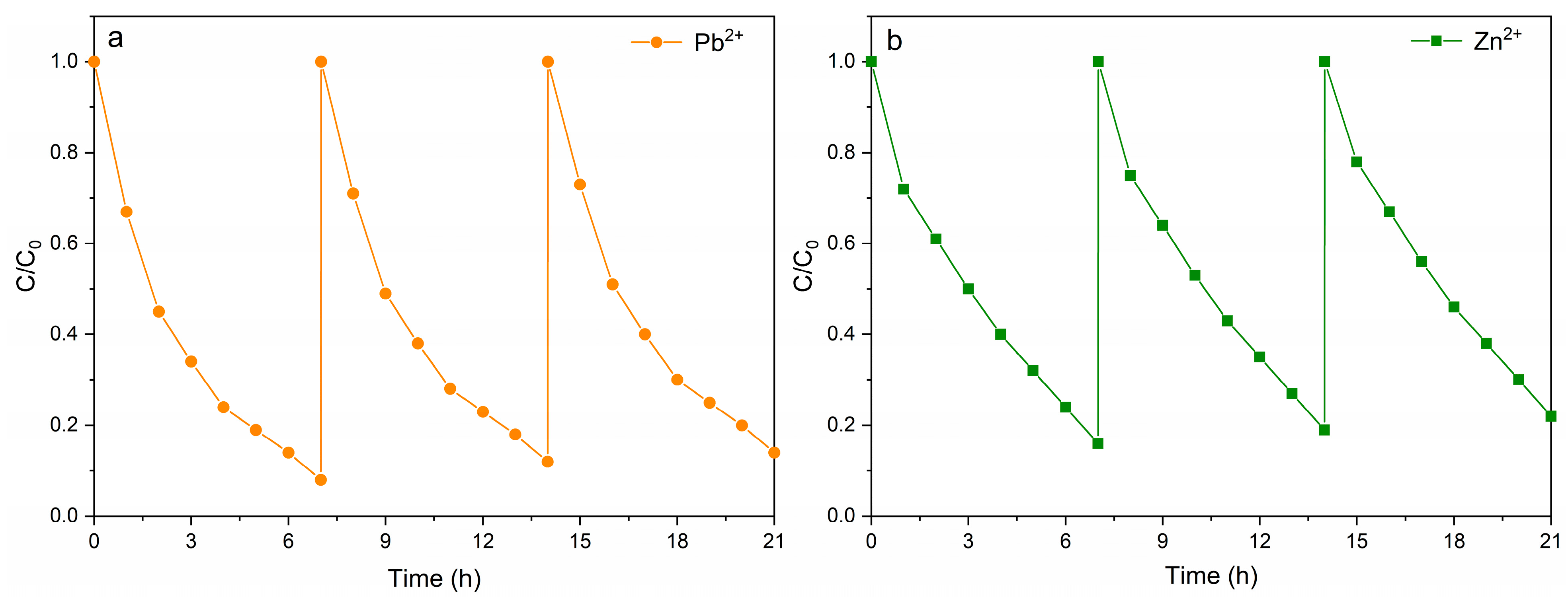
| Systems | Open-Circuit Voltage (mV) | Maximum Power Density (mW/m2) | Limiting Current Density (mA/m2) |
|---|---|---|---|
| Rut-B | 315.27 | 9.88 | 152.26 |
| Rutile | 236.91 | 7.21 | 115.67 |
| Biochar | 188.43 | 5.76 | 95.41 |
| Blank | 149.26 | 3.05 | 75.11 |
| Systems | Fitting Equation | Reaction Rate Constant (K/d−1) | R2 |
|---|---|---|---|
| Rut-B | y = 0.04705 + 0.3386x | 0.3386 | 0.9921 |
| Rutile | y = 0.00871 + 0.1379x | 0.1379 | 0.9947 |
| Biochar | y = 0.02587 + 0.0461x | 0.0461 | 0.9826 |
| Blank | y = −0.00678 + 0.0279x | 0.0279 | 0.9917 |
| Systems | Fitting Equation | Reaction Rate Constant (K/d−1) | R2 |
|---|---|---|---|
| Rut-B | y = 0.00061 + 0.2438x | 0.2438 | 0.9967 |
| Rutile | y = 0.03066 + 0.1088x | 0.1088 | 0.9874 |
| Biochar | y = 0.01925 + 0.0455x | 0.0455 | 0.9934 |
| Blank | y = −0.00369 + 0.0274x | 0.0274 | 0.9951 |
Disclaimer/Publisher’s Note: The statements, opinions and data contained in all publications are solely those of the individual author(s) and contributor(s) and not of MDPI and/or the editor(s). MDPI and/or the editor(s) disclaim responsibility for any injury to people or property resulting from any ideas, methods, instructions or products referred to in the content. |
© 2023 by the authors. Licensee MDPI, Basel, Switzerland. This article is an open access article distributed under the terms and conditions of the Creative Commons Attribution (CC BY) license (https://creativecommons.org/licenses/by/4.0/).
Share and Cite
Zhou, J.; Wang, L.; Wang, Z.; Feng, Y.; Luo, G.; Wang, Z.; Wu, J.; Hu, P. Enhanced Electricity Generation and Heavy Metal Removal by a Rutile–Biochar Cathode MFC. Minerals 2023, 13, 1250. https://doi.org/10.3390/min13101250
Zhou J, Wang L, Wang Z, Feng Y, Luo G, Wang Z, Wu J, Hu P. Enhanced Electricity Generation and Heavy Metal Removal by a Rutile–Biochar Cathode MFC. Minerals. 2023; 13(10):1250. https://doi.org/10.3390/min13101250
Chicago/Turabian StyleZhou, Jiqiang, Lei Wang, Zhe Wang, Yonglin Feng, Guangfeng Luo, Zhiyang Wang, Jing Wu, and Peiqing Hu. 2023. "Enhanced Electricity Generation and Heavy Metal Removal by a Rutile–Biochar Cathode MFC" Minerals 13, no. 10: 1250. https://doi.org/10.3390/min13101250
APA StyleZhou, J., Wang, L., Wang, Z., Feng, Y., Luo, G., Wang, Z., Wu, J., & Hu, P. (2023). Enhanced Electricity Generation and Heavy Metal Removal by a Rutile–Biochar Cathode MFC. Minerals, 13(10), 1250. https://doi.org/10.3390/min13101250








